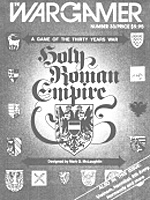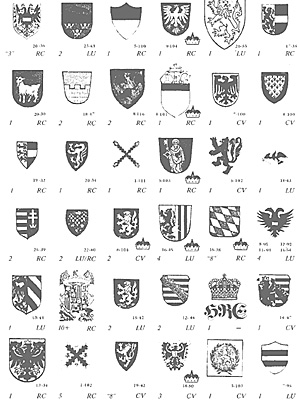 Designed by: Mark McLaughlin
Designed by: Mark McLaughlin
Published by: 3W; The Wargamer magazine, Issue 33 (September 1984)
What it’s about
The year is 1619. Matthias, emperor of Germany, has gone to his grave. A year-old rebellion in the Imperial province of Bohemia had divided the empire along religious and political line. Bohemian rebels have elected a minor German prince, Frederick, elector Palatine, as their King. Protestant princelings rally to Frederick, elevating his status to that of a rival to Emperor Ferdinand II, Archduke of Austria, for the Imperial throne. As mercenary armies are raised against Ferdinand, the Catholic King of Spain and Duke of Bavaria rally to his side. France and Sweden turn their attention to Germany in eager anticipation of the dismemberment of their great rival, the Holy Roman Empire.
HRE is a political and military game of the 17th Century struggle for empire that plunged Europe into one of its longest and most destructive wars. Up to six players control the major dynasties of the era, fielding armies, building navies and engaging in diplomatic intrigue, bribery and treachery that will decide who will wear the crown of the Holy Roman Empire.
Components
Container: Wargamer The #33 magazine,
1 Standard 8½”x11” 16-page Rules booklets
1 die-cut 5/8” 200 of sheet counters square double-sided
1 die-cut 5/8” 100 of sheet counters square double-sided
2 (72 cards 1”x1½” 36 of sheets total) cards
1 paper unmounted 22”x17” map game
Counter Manifest
Palatine/Spanish
Political Markers: Political White/Red, Gold/Red 32
Leaders Palatine White/Red 3
Leaders Spanish White/Red 3
Infantry Palatine Gold/Red 1
Infantry Spanish Gold/Red 6
Spanish Fleets Gold/Red 3
Austrian/French Markers
Political Black/Gold; Lt Blue Gold 28
Leaders Austrian Black/Gold B 4
Leaders French Gold/Lt.Blue 3
Cavalry French Gold/Lt Blue3
Navies French Gold/Lt. Blue 2
Bavarian/Swedish Markers
Political Dk Blue; White Dk Blue Gold 32
Leaders Bavarian White/Dk. Blue 3
Infantry Bavarian White/Dk. Blue 1
Infantry Swedish Gold/Dk. Blue 4
Cavalry Swedish Gold/Dk. Blue 2
Artillery Swedish Gold/Dk. Blue 2
Reiter Mercenary Cavalry/Regular Infantry Black/White 42
Light Mercenary Cavalry/Elite Cavalry Black/White 6
Mercenary Gendarme Cavalry/Reiter Cavalry Black/White 4
Mercenary Fleets Black/White B 1
Mercenary Artillery Black/White B 6
Leaders Hanse Black/White 4
Crown Hanse Black/White 1
Infantry Dutch Black/Green 4
Navies Dutch Black/Green 2
Leader Dutch Black/Green 1
Cavalry Dutch Black/Green 1
Artillery Dutch Black/Green 1
Leader Danish Gold/White 1
Navy Danish Gold/White 1
Infantry Swiss Gold/Green 4
Leader Swiss Gold/Green 1
Leader Saxon Black/Grey 1
Infantry Saxon Black/Grey 1
Cavalry Saxon Black/Grey 1
Brandenburg Infantry Grey/Blue 2
Brandenburg Leader Grey/Blue 1
Reiter Polish Cavalry/Gendarme Cavalry Black/Orange 2
Regular Polish Infantry/Mercenary Cavalry Reiter Black/Orange; Black/White 2
Reiter Polish Cavalry/Mercenary Infantry Regular Black/Orange; Black/White 2
Elite Polish Cavalry/Mercenary Cavalry Light Black/Orange; Black/White 2
Light Polish Cavalry/Mercenary Cavalry Elite Black/Orange; Black/White 2
Wagons Black/White 2
Markers Forest F lack/Tan 3
Forest/Town Marker Black/Tan 1
Bridge/Gate Markers Black/Tan 2
Markers Hill Black/Tan 3
Marker Hill/Town Black/Tan 1
Fortress/Sacked Town Markers
Black/Tan 10
Markers National Black/Tan 6
- Note: 40 of the 300 counters are blanks, colored white on both sides.
Cards
AUS. Hereditary Archduke of Austria; Duke of Carniola; Duke of Carinthia; Archduke of Styria; Count of Tyrol
AUS. Influence Archbishop of Mainz; Archbishop of Cologne; Archbishop of Trier
Brand. Hereditary Elector of Brandenberg
Brand. Influence Duke of Pomerania
Brand. Control Count of Mark, Duke of Berg, Duke of Prussia
HRE Control King of Hungary, Duke of Silesia; Duke of Lusatia; Margrave of Moravia
HRE City Imperial Burgomeister of Nurnberg
Spanish Reserve King of Spain
Spanish Control ; Governor of Netherlands; Duke of Milan; Count of Alsace; Count of Franche-Comte; Count of Luxembourg
Pal. Hereditary Count of Palatine; Elector of Palatine
Pal. Control King of Bohemia
Pal. Influence King of Denmark
Saxon Hereditary Elector of Saxony
Saxon Control Duke of Saxony
Bav. Hereditary Duke of Bavaria
French Reserve King of France
Swedish Reserve King of Sweden
Pure Mercenary George von Arnim
Holy Roman Emperor
Hanseatic League
Swiss Cantons
King Poland
Sultan the Porte
Prince Transylvania; Anhalt;
Archbishop Bremen; Salzburg; Magdeburg
Bishop Munster; Nassau; Halberstadt; Strassburg; Metz; Augsburg; Bamberg; Wurzburg; Osnabruck
Doge Venice
Duke Savoy; Cleves; Lorraine; Wurtemburg; Brunswick; Mecklenburg; Brunswick-Luneberg
Count Oldenburg Bayreuth;
Stadtholder United Provinces
Margrave Anspach Baden-Durlach;
Landgrave hesse- Hesse-Cassel; Darmstadt
Grissons Telline Val
Erich von Mansfield
Albrecht von Wallenstein
Bernard von Saxe-Weimar
 Player’s Value per 3W’s Alan Poulter
Player’s Value per 3W’s Alan Poulter
I think it’s a great, very playable game, although one in need of some rules clarifications (and who isn’t?). The economic system, with it’s high maintenance regardless of unit quality, really brings across one of the basic reasons the war lasted so long: anyone can raise a sizeable low quality army but it is very had to maintain one, and so the high quality armies (French knights; Swedish, Spanish, Swiss or Dutch Infantry) take on an importance out of all relation to their size.
Further, the combat is very simple if you do not use the tactical module (I never have), with just enough chrome (cavalry and artillery special effects in siege, elite unit cohesion, light cavalry persuit) to keep it from becoming Riskian. Basically on a level with Successors.
The diplomatic game, which is largely a series of auctions for the different principalities of the Empire and for the mercenary leaders and armies, is close to being the heart of the game, and it works nicely, giving advantages for dynastic and religious links. It really gives the feeling of a free-for-all civil war with foreign intervention, as well as for pre-modern (i.e. pre-French Revolution) strategy, with the non-national and mercenary armies being a threat as much as an asset (other players can bid them away from you while they’re still on your territory).
The game also has a Pax Britannica-like three step control process, starting with mere conquest (ends as soon as you pull your army out), influence, and control of territories. This makes it possible to expand your territory and economy without such ahistorical happenings as the Bohemians turning from rebels to loyal imperials overnight. The sacking rule helps to accomplish the same thing.
Further, the card game aspect (a different card for each province/principality) and the Imperial rules (elections and diets) allows a lot of special rules that come up in different parts of the game.
For instance, certain territories have special powers indicated on their cards (Holland raises and supports its own army, but makes you keep it near Holland; Transylvania produces free light cavalry; Saxony and Brandenburg have national armies, but they are prone to flee when under foreign control), and some rules change depending on statutes passed by the imperial diet.
Best of all, Holy Roman Empire has great great great victory conditions, with radically different conditions for each of the six possible players, and yet with more than one way for each player to win. The best I’ve seen in this area since Illuminati.
This is perhaps my most played strategic game. I’d say its only rival for a playable game that actually makes you feel like a national leader of the time is Empires of the Middle Ages, and EotMA always seemed too abstract for my liking (not that this has stopped me from playing the various computer versions hundreds of times). Someone please buy the rights to it, clean it up, and re-release it. It might even lend itself to computer play.
Collector’s Value
Prices for issues of The Wargamer, Volume I, tend to fall into the $5 – $50 range, with the earlier issues commanding greater prices than the later issues. The HRE issue, number 33, is generally the most difficult to locate and most expensive to acquire.
Boone lists low, high and average prices of 6/37/19.13 at auction and 10/50/29.77 for sale.
Other games of this type
The Thirty Years War has inspired several games, examining both the war as a whole and individual battles. These games include: Breitenfeld (S&T 55) Breitenfeld (ADA) Breitenfeld (Panzerfaust Pubs) Thirty Years War Quad (SPI) [Freiburg; Lutzen; Nordlingen; Rocroi] Lion of the North (GMT) Sixteen Thirty Something (Warfrog) Thirty Years War (Decision Games) With Fire & Sword (SimCan) Las Dunas 1658 (Ludopress) Rocroi 1643 (Histoire & Collections) the Thirty Years War (Q Games)
Other games by this designer
Army of the Potomac (3W) Army of the Tennessee (3W) Mr. Lincoln’s War (3W) Viceroys (Task Force Games) War and Peace (AH) No Trumpets, No Drums (3W) East Wind Rain (3W and TFG) Princess Ryan’s Star Marines (AH)
Back to Simulacrum Vol. 4 No. 1 Table of Contents
Back to Simulacrum List of Issues
Back to MagWeb Master Magazine List
© Copyright 2001 by Steambubble Graphics
This article appears in MagWeb (Magazine Web) on the Internet World Wide Web. Other articles from military history and related magazines are available at http://www.magweb.com